Related Research Articles
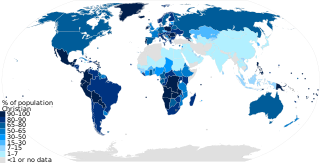
The terms Christendom or Christian world commonly refer to the global Christian community, Christian states, Christian-majority countries or countries in which Christianity is dominant or prevails.
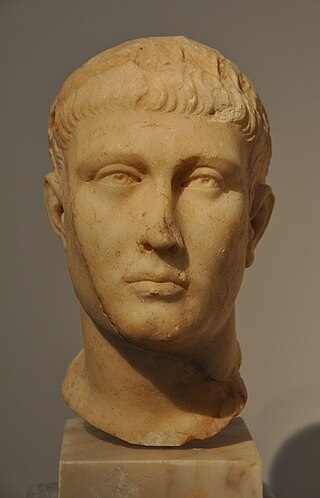
Theodosius I, also known as Theodosius the Great, was a Roman emperor from 379 to 395. He won two civil wars and was instrumental in establishing the Nicene Creed as the orthodox doctrine for Nicene Christianity. Theodosius was the last emperor to rule the entire Roman Empire before its administration was permanently split between the Western Roman Empire and the Eastern Roman Empire. He ended the Gothic War (376–382) with terms disadvantageous to the empire, with the Goths remaining within Roman territory but as nominal allies with political autonomy.

The 4th century was the time period from 301 CE to 400 CE (CD) in accordance with the Julian calendar. In the West, the early part of the century was shaped by Constantine the Great, who became the first Roman emperor to adopt Christianity. Gaining sole reign of the empire, he is also noted for re-establishing a single imperial capital, choosing the site of ancient Byzantium in 330 to build the city soon called Nova Roma ; it was later renamed Constantinople in his honor.
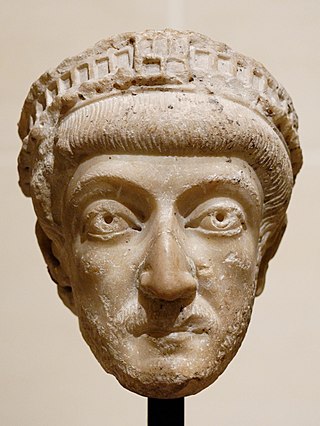
Theodosius II was Roman emperor from 402 to 450. He was proclaimed Augustus as an infant and ruled as the Eastern Empire's sole emperor after the death of his father, Arcadius, in 408. His reign was marked by the promulgation of the Theodosian law code and the construction of the Theodosian Walls of Constantinople. He also presided over the outbreak of two great Christological controversies, Nestorianism and Eutychianism.

The Edict of Milan was the February, AD 313 agreement to treat Christians benevolently within the Roman Empire. Western Roman Emperor Constantine I and Emperor Licinius, who controlled the Balkans, met in Mediolanum and, among other things, agreed to change policies towards Christians following the edict of toleration issued by Emperor Galerius two years earlier in Serdica. The Edict of Milan gave Christianity legal status and a reprieve from persecution but did not make it the state church of the Roman Empire, which occurred in AD 380 with the Edict of Thessalonica, when Nicene Christianity received normative status.

The Constantinian shift was, according to some theologians and historians of antiquity, a set of political and theological changes that took place during the 4th-century under the leadership of Emperor Constantine the Great. Rodney Clapp claims that the shift or change started in the year 200. The term was popularized by the Mennonite theologian John H. Yoder. He claims that the change was not just freedom from persecution but an alliance between the State and the Church that led to a kind of Caesaropapism. The claim that there ever was a Constantinian shift has been disputed; Peter Leithart argues that there was a "brief, ambiguous 'Constantinian moment' in the fourth century", but that there was "no permanent, epochal 'Constantinian shift'".
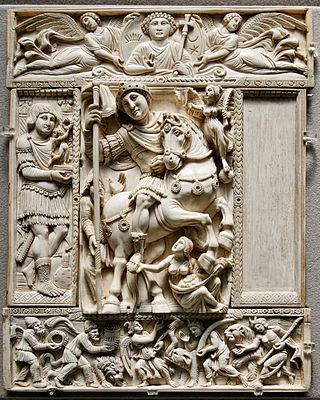
Late antiquity is sometimes defined as spanning from the end of classical antiquity to the local start of the Middle Ages, from around the late 3rd century up to the 7th or 8th century in Europe and adjacent areas bordering the Mediterranean Basin depending on location. The popularisation of this periodization in English has generally been credited to historian Peter Brown, who proposed a period between 150 and 750 AD. The Oxford Centre for Late Antiquity defines it as "the period between approximately 250 and 750 AD". Precise boundaries for the period are a continuing matter of debate. In the West, its end was earlier, with the start of the Early Middle Ages typically placed in the 6th century, or even earlier on the edges of the Western Roman Empire.

The Dominate, also known as the late Roman Empire, is the despotic form of imperial government of the late Roman Empire. It followed the earlier period known as the Principate. Until the empire was reunited c. 324, this phase is more often called the Tetrarchy.

During the reign of the Roman emperor Constantine the Great (306–337 AD), Christianity began to transition to the dominant religion of the Roman Empire. Historians remain uncertain about Constantine's reasons for favoring Christianity, and theologians and historians have often argued about which form of early Christianity he subscribed to. There is no consensus among scholars as to whether he adopted his mother Helena's Christianity in his youth, or, as claimed by Eusebius of Caesarea, encouraged her to convert to the faith he had adopted.

Julian is a 1964 novel by Gore Vidal, a work of historical fiction written primarily in the first person dealing with the life of the Roman emperor Flavius Claudius Julianus, who reigned briefly from 361 to 363 A.D.

The growth of Early Christianity from its obscure origin c. AD 40, with fewer than 1,000 followers, to being the majority religion of the entire Roman Empire by AD 400, has been examined through a wide variety of historiographical approaches.
In historiography, the Late or Later Roman Empire, traditionally covering the period from 284 CE to 641 CE, was a time of significant transformation in Roman governance, society, and religion. Diocletian's reforms, including the establishment of the tetrarchy, aimed to address the vastness of the empire and internal instability. The rise of Christianity, legalized by Constantine in 313 CE, profoundly changed the religious landscape, becoming a central force in Roman life. Simultaneously, barbarian invasions, particularly by the Goths and Huns, weakened the Western Roman Empire, which collapsed in 476 CE. In contrast, the Eastern Roman Empire endured, evolving into the Byzantine Empire and laying the foundations for medieval Europe.

Paganism is commonly used to refer to various religions that existed during Antiquity and the Middle Ages, such as the Greco-Roman religions of the Roman Empire, including the Roman imperial cult, the various mystery religions, religious philosophies such as Neoplatonism and Gnosticism, and more localized ethnic religions practiced both inside and outside the empire. During the Middle Ages, the term was also adapted to refer to religions practiced outside the former Roman Empire, such as Germanic paganism, Egyptian paganism and Baltic paganism.
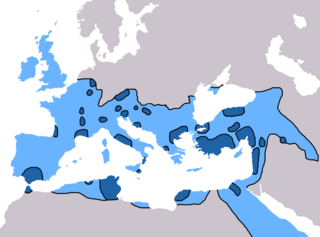
Christianity in the 4th century was dominated in its early stage by Constantine the Great and the First Council of Nicaea of 325, which was the beginning of the period of the First seven Ecumenical Councils (325–787), and in its late stage by the Edict of Thessalonica of 380, which made Nicene Christianity the state church of the Roman Empire.
The Edict of Thessalonica, issued on 27 February AD 380 by Theodosius I, made Nicene Christianity the state church of the Roman Empire. It condemned other Christian creeds such as Arianism as heresies of "foolish madmen," and authorized their punishment.

Christianity in late antiquity traces Christianity during the Christian Roman Empire — the period from the rise of Christianity under Emperor Constantine, until the fall of the Western Roman Empire. The end-date of this period varies because the transition to the sub-Roman period occurred gradually and at different times in different areas. One may generally date late ancient Christianity as lasting to the late 6th century and the re-conquests under Justinian of the Byzantine Empire, though a more traditional end-date is 476, the year in which Odoacer deposed Romulus Augustus, traditionally considered the last western emperor.
In the year before the First Council of Constantinople in 381, Christianity became the official religion of the Roman Empire when Theodosius I, emperor of the East, Gratian, emperor of the West, and Gratian's junior co-ruler Valentinian II issued the Edict of Thessalonica in 380, which recognized the catholic orthodoxy of Nicene Christians as the Roman Empire's state religion. Historians refer to the Nicene church associated with emperors in a variety of ways: as the catholic church, the orthodox church, the imperial church, the Roman church, or the Byzantine church, although some of those terms are also used for wider communions extending outside the Roman Empire. The Eastern Orthodox Church, Oriental Orthodoxy, and the Catholic Church all claim to stand in continuity from the Nicene church to which Theodosius granted recognition.
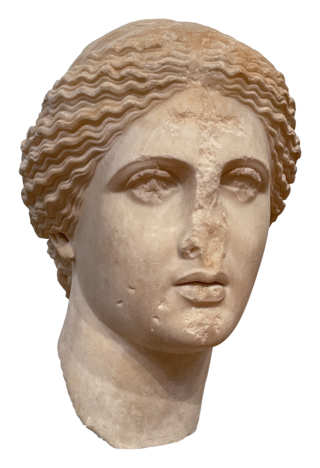
Persecution of pagans in the late Roman Empire began during the reign of Constantine the Great in the military colony of Aelia Capitolina (Jerusalem), when he destroyed a pagan temple for the purpose of constructing a Christian church. Rome had periodically confiscated church properties, and Constantine was vigorous in reclaiming them whenever these issues were brought to his attention. Christian historians alleged that Hadrian had constructed a temple to Venus on the site of the crucifixion of Jesus on Golgotha hill in order to suppress Christian veneration there. Constantine used that to justify the temple's destruction, saying he was simply reclaiming the property. Using the vocabulary of reclamation, Constantine acquired several more sites of Christian significance in the Holy Land.

Christianity was present in Roman Britain from at least the third century until the end of the Roman imperial administration in the early fifth century, and continued in western Britain.
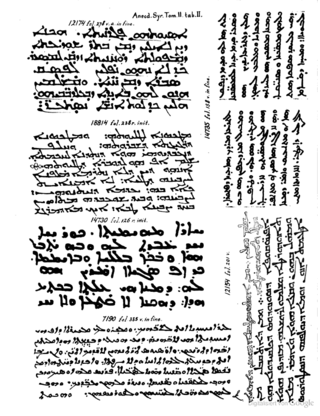
The Syro-Roman law book is a compilation of secular legal texts from the eastern Roman Empire originally composed in Greek in the late 5th century, but surviving only in Syriac translation. As a work of Roman law, the original language of many of its legal texts would have been Latin.